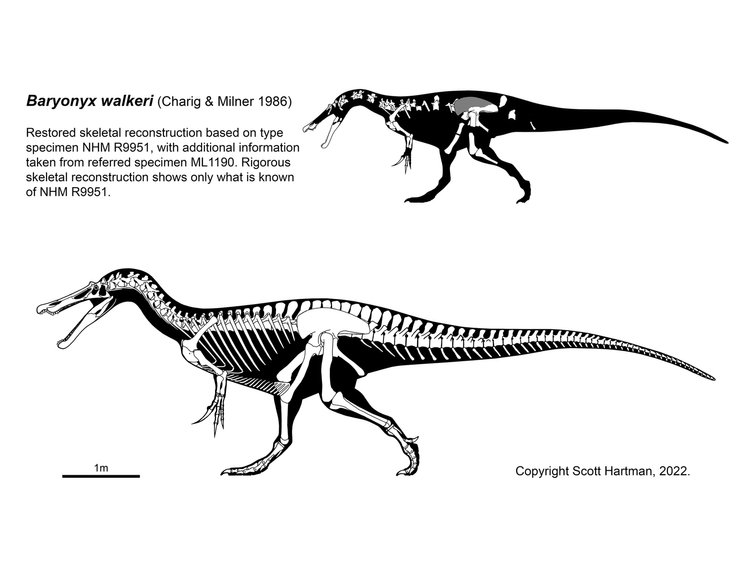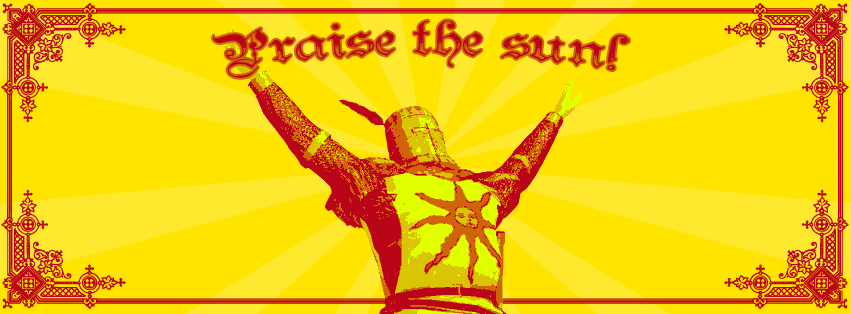Post by themechabaryonyx789 on Feb 1, 2014 12:03:24 GMT
Baryonyx walkeri:

Scientific classification: Subfamily; Baryonichinae. Family; Spinosaurid. Taxon; Megalosauroid. Dinosaur type; Theropoda
Size: The adult size of Baryonyx is unknown. The immature (not fully grown) specimen found is ~9.5 metres in length and 2.6 tons in weight.
Temporal range: 130 mya and after.
Location: England, France and other locations in Europe.
Description:
Baryonyx was the largest predator in its day, and coexisted with Neovenator, Iguanodon, Eotyrannus and other large dinosaurs. It is so far only known from immature specimens, so any adult size estimates are speculation. Baryonyx hunted both aquatic and terrestrial animals, as the stomach contents of the immature specimen contains remains from a sub-adult Iguanodon and numerous fish scales.
biostor.org/cache/pdf/b1/0a/84/b10a84017a1e1fae1b74a743432f7b97.pdf
The skull of Baryonyx:
'Despite the limited amount of material available, several interesting observations may be made on the skull. It appears to have been long, at least in its anterior position. Whereas in other theropods the extreme anterior end of the premaxilla gives rise to the steeply ascending nasal process, forming the anterior margin of the external naris, in Baryonyx there is no trace of such a process, and the anterior 170 mm of the conjoined premaxillae form a long low rostrum with a smoothly rounded dorsal surface. Even behind this rostrum there is no ascending process, the confluence external nares appearing merely as an extensive opening lying well back from the tip of the rostrum and passing horizontally from one side of the snout to the other. The first 130 mm of the rostrum are expanded laterally into a spatulate 'rosette', not unlike that found in modern gavials: the first 70 mm of its lower margin are turned down in lateral view. Behind the 'rosette' the rostrum is remarkably narrow from side to side as seen in dorsal view. The maxilla fits onto the hind part of the ventral margin of the premaxilla by a complex articulation. The resulting effect is that the line of the upper tooth row, passing backwards from the front of the snout, first rises a little then, at the junction of the two elements, curves strongly downwards and finally flattens out to run horizontally along the vertal margin of the maxilla. The net effect of this sigmoid curvature is that the front of the rostrum is elevated above the level of the maxillary row, not depressed beneath it. This elevation is reflected in the upper shape of the margin in the dentary, the 140 mm of which slope strongly upwards towards its anterior end. Nevertheless, in the region of the 5* to 6* premaxillary teeth, the gap between the upper and lower jaws seems to have been much wider than elsewhere and may be termed he subrostral notch.'
 <Reconstruction of the skull of the Baryonyx holotype
<Reconstruction of the skull of the Baryonyx holotype
Also according to Emily Rayfield's studies, Baryonyx had a more robust skull for its body length than Spinosaurus, which is in a different sub-family.
The fore limb of Baryonyx:
'As is typical of theropods, all three major bones are short, relative to the general size of the animal; but Baryonyx's forelimbs are also remarkably robust and wide, relative to their shortness with stout shafts and broadly expanded ends. The left humerus is essentially complete, although the medial side of the shaft is somewhat crushed. The right humerus shows a similar state of preservation, but lacks almost the whole of the ectepicondyle. The element is 463 mm long (Charig and Milner 1990).'
(The picture of the humerus is on page 35 of the paper I presented underneath the description)
The heavy claw of Baryonyx:
Baryonyx's thumb claw is very large, measuring at around 30 cm in length. The claw is very thick at the top, and appears to curve at the end. This suggests that it was useful for grappling and tearing, rather than slashing. This also explains why Baryonyx has such robust forelimbs.

Scott Hartman's reconstruction of the immature (not fully grown) Baryonyx specimen:

Body features:
Relatively long and elongated neck
Relatively high leg:body ratio
Wide ribcage
Long jaws
Robust forelimbs, large humerus
Large and curved claws
Large femur

Scientific classification: Subfamily; Baryonichinae. Family; Spinosaurid. Taxon; Megalosauroid. Dinosaur type; Theropoda
Size: The adult size of Baryonyx is unknown. The immature (not fully grown) specimen found is ~9.5 metres in length and 2.6 tons in weight.
Temporal range: 130 mya and after.
Location: England, France and other locations in Europe.
Description:
Baryonyx was the largest predator in its day, and coexisted with Neovenator, Iguanodon, Eotyrannus and other large dinosaurs. It is so far only known from immature specimens, so any adult size estimates are speculation. Baryonyx hunted both aquatic and terrestrial animals, as the stomach contents of the immature specimen contains remains from a sub-adult Iguanodon and numerous fish scales.
biostor.org/cache/pdf/b1/0a/84/b10a84017a1e1fae1b74a743432f7b97.pdf
The skull of Baryonyx:
'Despite the limited amount of material available, several interesting observations may be made on the skull. It appears to have been long, at least in its anterior position. Whereas in other theropods the extreme anterior end of the premaxilla gives rise to the steeply ascending nasal process, forming the anterior margin of the external naris, in Baryonyx there is no trace of such a process, and the anterior 170 mm of the conjoined premaxillae form a long low rostrum with a smoothly rounded dorsal surface. Even behind this rostrum there is no ascending process, the confluence external nares appearing merely as an extensive opening lying well back from the tip of the rostrum and passing horizontally from one side of the snout to the other. The first 130 mm of the rostrum are expanded laterally into a spatulate 'rosette', not unlike that found in modern gavials: the first 70 mm of its lower margin are turned down in lateral view. Behind the 'rosette' the rostrum is remarkably narrow from side to side as seen in dorsal view. The maxilla fits onto the hind part of the ventral margin of the premaxilla by a complex articulation. The resulting effect is that the line of the upper tooth row, passing backwards from the front of the snout, first rises a little then, at the junction of the two elements, curves strongly downwards and finally flattens out to run horizontally along the vertal margin of the maxilla. The net effect of this sigmoid curvature is that the front of the rostrum is elevated above the level of the maxillary row, not depressed beneath it. This elevation is reflected in the upper shape of the margin in the dentary, the 140 mm of which slope strongly upwards towards its anterior end. Nevertheless, in the region of the 5* to 6* premaxillary teeth, the gap between the upper and lower jaws seems to have been much wider than elsewhere and may be termed he subrostral notch.'
 <Reconstruction of the skull of the Baryonyx holotype
<Reconstruction of the skull of the Baryonyx holotype Also according to Emily Rayfield's studies, Baryonyx had a more robust skull for its body length than Spinosaurus, which is in a different sub-family.
The fore limb of Baryonyx:
'As is typical of theropods, all three major bones are short, relative to the general size of the animal; but Baryonyx's forelimbs are also remarkably robust and wide, relative to their shortness with stout shafts and broadly expanded ends. The left humerus is essentially complete, although the medial side of the shaft is somewhat crushed. The right humerus shows a similar state of preservation, but lacks almost the whole of the ectepicondyle. The element is 463 mm long (Charig and Milner 1990).'
(The picture of the humerus is on page 35 of the paper I presented underneath the description)
The heavy claw of Baryonyx:
Baryonyx's thumb claw is very large, measuring at around 30 cm in length. The claw is very thick at the top, and appears to curve at the end. This suggests that it was useful for grappling and tearing, rather than slashing. This also explains why Baryonyx has such robust forelimbs.

Scott Hartman's reconstruction of the immature (not fully grown) Baryonyx specimen:

Body features:
Relatively long and elongated neck
Relatively high leg:body ratio
Wide ribcage
Long jaws
Robust forelimbs, large humerus
Large and curved claws
Large femur









